Director's Responsibilities in Australian Company Insolvency
VerifiedAdded on 2020/04/07
|11
|2651
|52
Essay
AI Summary
In Australia, the legal framework surrounding insolvency is primarily governed by the Corporations Act 2001, which outlines the duties and responsibilities of company directors during periods of financial distress. Directors play a pivotal role in mitigating losses for creditors when a company becomes insolvent. A key aspect of their responsibility involves preventing insolvent trading, where a director knowingly allows a company to incur debts while it is unable to pay them as they fall due. Failure to comply with these duties can result in personal liability for the directors. Directors must balance the interests of various stakeholders and take proactive steps such as seeking professional advice, restructuring operations, or considering voluntary administration to navigate through financial difficulties. This essay explores these directorial obligations, emphasizing the legal consequences and strategic actions necessary to fulfill their roles during insolvency.
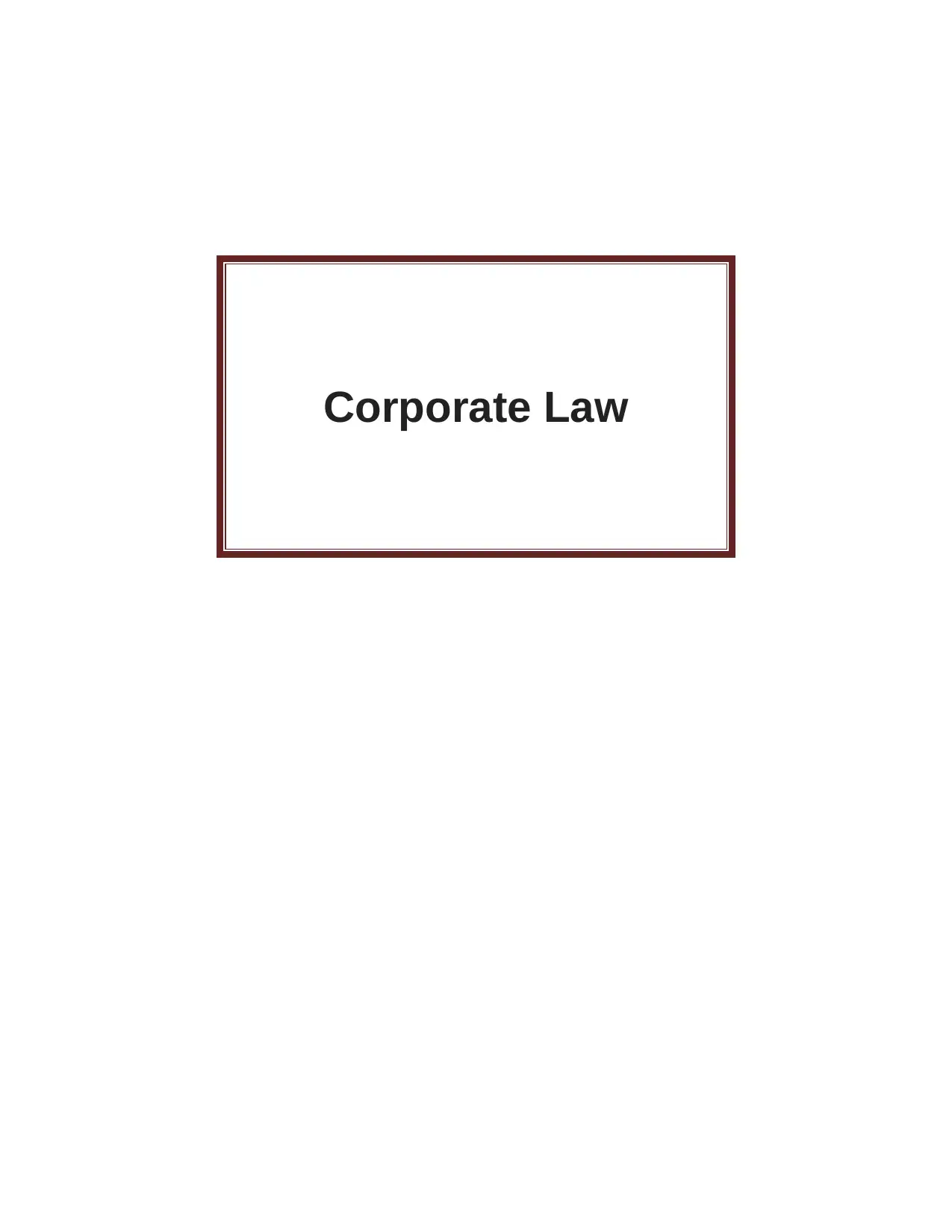
Corporate Law
Secure Best Marks with AI Grader
Need help grading? Try our AI Grader for instant feedback on your assignments.
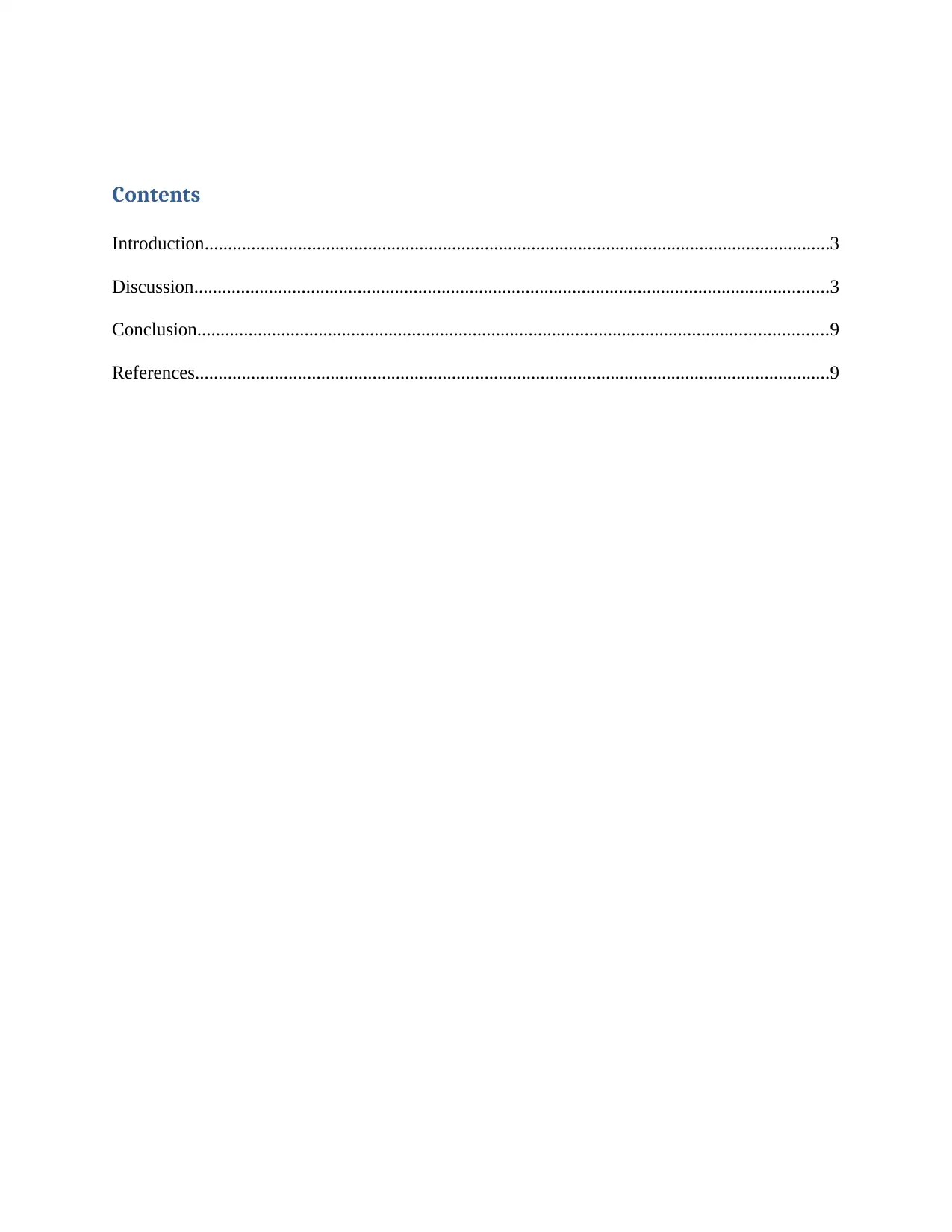
Contents
Introduction......................................................................................................................................3
Discussion........................................................................................................................................3
Conclusion.......................................................................................................................................9
References........................................................................................................................................9
Introduction......................................................................................................................................3
Discussion........................................................................................................................................3
Conclusion.......................................................................................................................................9
References........................................................................................................................................9
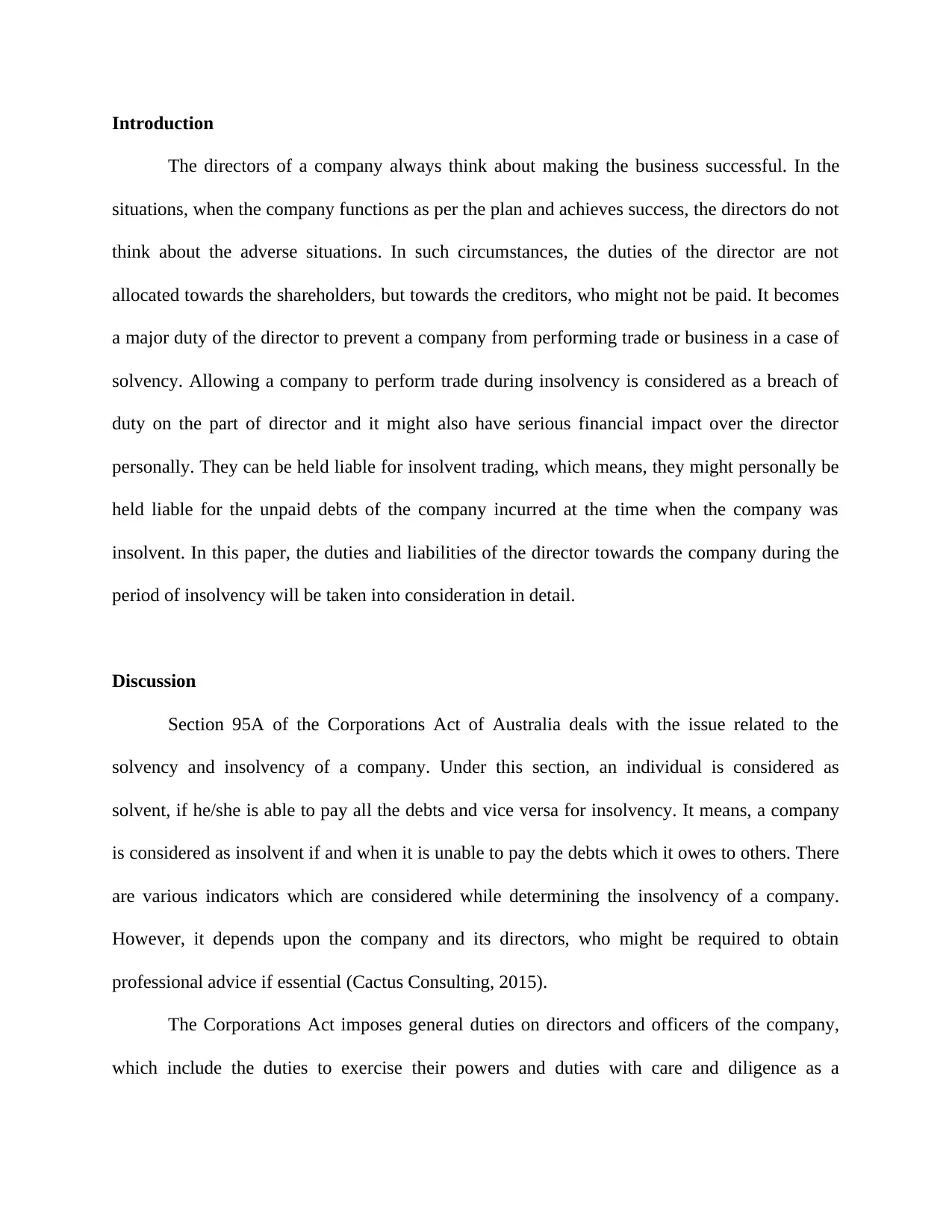
Introduction
The directors of a company always think about making the business successful. In the
situations, when the company functions as per the plan and achieves success, the directors do not
think about the adverse situations. In such circumstances, the duties of the director are not
allocated towards the shareholders, but towards the creditors, who might not be paid. It becomes
a major duty of the director to prevent a company from performing trade or business in a case of
solvency. Allowing a company to perform trade during insolvency is considered as a breach of
duty on the part of director and it might also have serious financial impact over the director
personally. They can be held liable for insolvent trading, which means, they might personally be
held liable for the unpaid debts of the company incurred at the time when the company was
insolvent. In this paper, the duties and liabilities of the director towards the company during the
period of insolvency will be taken into consideration in detail.
Discussion
Section 95A of the Corporations Act of Australia deals with the issue related to the
solvency and insolvency of a company. Under this section, an individual is considered as
solvent, if he/she is able to pay all the debts and vice versa for insolvency. It means, a company
is considered as insolvent if and when it is unable to pay the debts which it owes to others. There
are various indicators which are considered while determining the insolvency of a company.
However, it depends upon the company and its directors, who might be required to obtain
professional advice if essential (Cactus Consulting, 2015).
The Corporations Act imposes general duties on directors and officers of the company,
which include the duties to exercise their powers and duties with care and diligence as a
The directors of a company always think about making the business successful. In the
situations, when the company functions as per the plan and achieves success, the directors do not
think about the adverse situations. In such circumstances, the duties of the director are not
allocated towards the shareholders, but towards the creditors, who might not be paid. It becomes
a major duty of the director to prevent a company from performing trade or business in a case of
solvency. Allowing a company to perform trade during insolvency is considered as a breach of
duty on the part of director and it might also have serious financial impact over the director
personally. They can be held liable for insolvent trading, which means, they might personally be
held liable for the unpaid debts of the company incurred at the time when the company was
insolvent. In this paper, the duties and liabilities of the director towards the company during the
period of insolvency will be taken into consideration in detail.
Discussion
Section 95A of the Corporations Act of Australia deals with the issue related to the
solvency and insolvency of a company. Under this section, an individual is considered as
solvent, if he/she is able to pay all the debts and vice versa for insolvency. It means, a company
is considered as insolvent if and when it is unable to pay the debts which it owes to others. There
are various indicators which are considered while determining the insolvency of a company.
However, it depends upon the company and its directors, who might be required to obtain
professional advice if essential (Cactus Consulting, 2015).
The Corporations Act imposes general duties on directors and officers of the company,
which include the duties to exercise their powers and duties with care and diligence as a
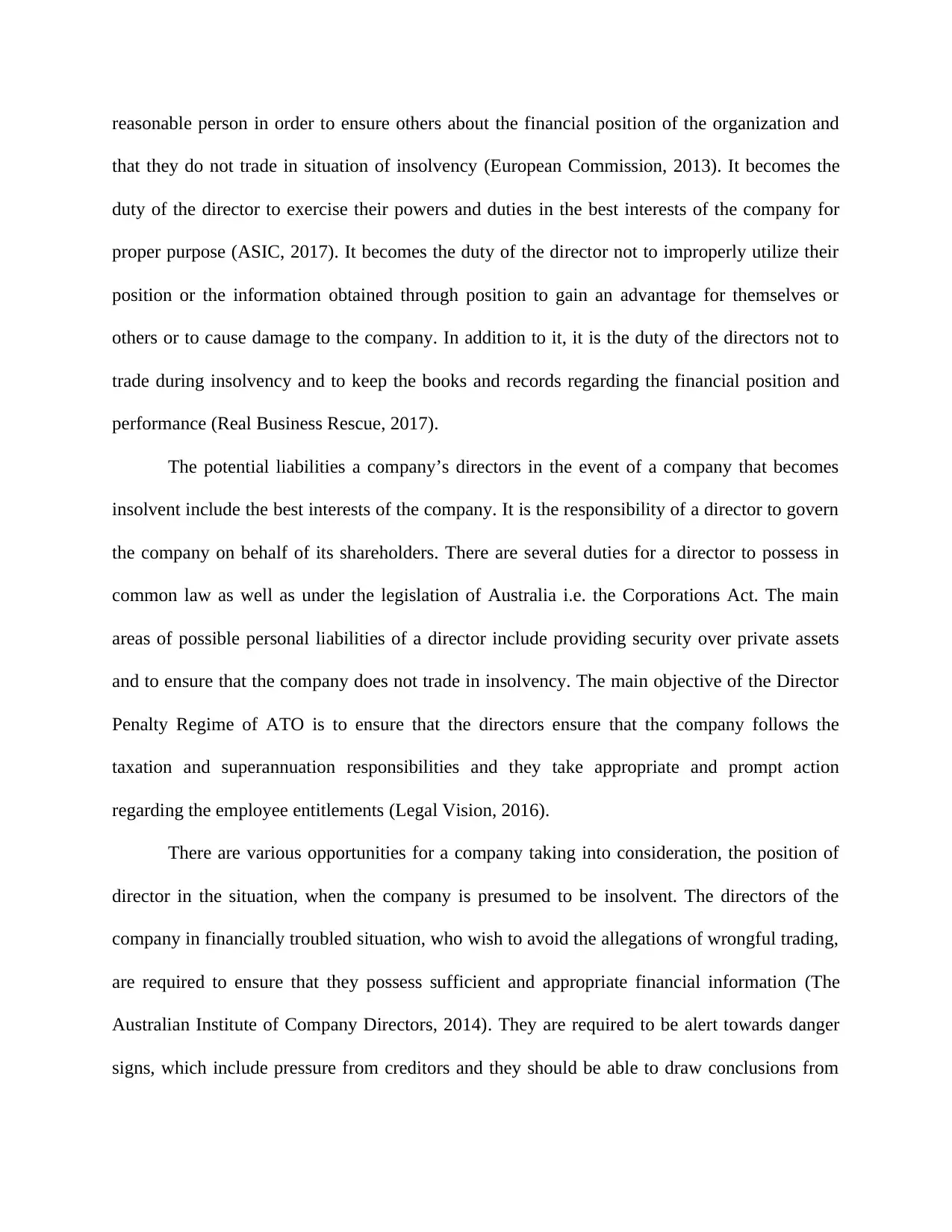
reasonable person in order to ensure others about the financial position of the organization and
that they do not trade in situation of insolvency (European Commission, 2013). It becomes the
duty of the director to exercise their powers and duties in the best interests of the company for
proper purpose (ASIC, 2017). It becomes the duty of the director not to improperly utilize their
position or the information obtained through position to gain an advantage for themselves or
others or to cause damage to the company. In addition to it, it is the duty of the directors not to
trade during insolvency and to keep the books and records regarding the financial position and
performance (Real Business Rescue, 2017).
The potential liabilities a company’s directors in the event of a company that becomes
insolvent include the best interests of the company. It is the responsibility of a director to govern
the company on behalf of its shareholders. There are several duties for a director to possess in
common law as well as under the legislation of Australia i.e. the Corporations Act. The main
areas of possible personal liabilities of a director include providing security over private assets
and to ensure that the company does not trade in insolvency. The main objective of the Director
Penalty Regime of ATO is to ensure that the directors ensure that the company follows the
taxation and superannuation responsibilities and they take appropriate and prompt action
regarding the employee entitlements (Legal Vision, 2016).
There are various opportunities for a company taking into consideration, the position of
director in the situation, when the company is presumed to be insolvent. The directors of the
company in financially troubled situation, who wish to avoid the allegations of wrongful trading,
are required to ensure that they possess sufficient and appropriate financial information (The
Australian Institute of Company Directors, 2014). They are required to be alert towards danger
signs, which include pressure from creditors and they should be able to draw conclusions from
that they do not trade in situation of insolvency (European Commission, 2013). It becomes the
duty of the director to exercise their powers and duties in the best interests of the company for
proper purpose (ASIC, 2017). It becomes the duty of the director not to improperly utilize their
position or the information obtained through position to gain an advantage for themselves or
others or to cause damage to the company. In addition to it, it is the duty of the directors not to
trade during insolvency and to keep the books and records regarding the financial position and
performance (Real Business Rescue, 2017).
The potential liabilities a company’s directors in the event of a company that becomes
insolvent include the best interests of the company. It is the responsibility of a director to govern
the company on behalf of its shareholders. There are several duties for a director to possess in
common law as well as under the legislation of Australia i.e. the Corporations Act. The main
areas of possible personal liabilities of a director include providing security over private assets
and to ensure that the company does not trade in insolvency. The main objective of the Director
Penalty Regime of ATO is to ensure that the directors ensure that the company follows the
taxation and superannuation responsibilities and they take appropriate and prompt action
regarding the employee entitlements (Legal Vision, 2016).
There are various opportunities for a company taking into consideration, the position of
director in the situation, when the company is presumed to be insolvent. The directors of the
company in financially troubled situation, who wish to avoid the allegations of wrongful trading,
are required to ensure that they possess sufficient and appropriate financial information (The
Australian Institute of Company Directors, 2014). They are required to be alert towards danger
signs, which include pressure from creditors and they should be able to draw conclusions from
Secure Best Marks with AI Grader
Need help grading? Try our AI Grader for instant feedback on your assignments.
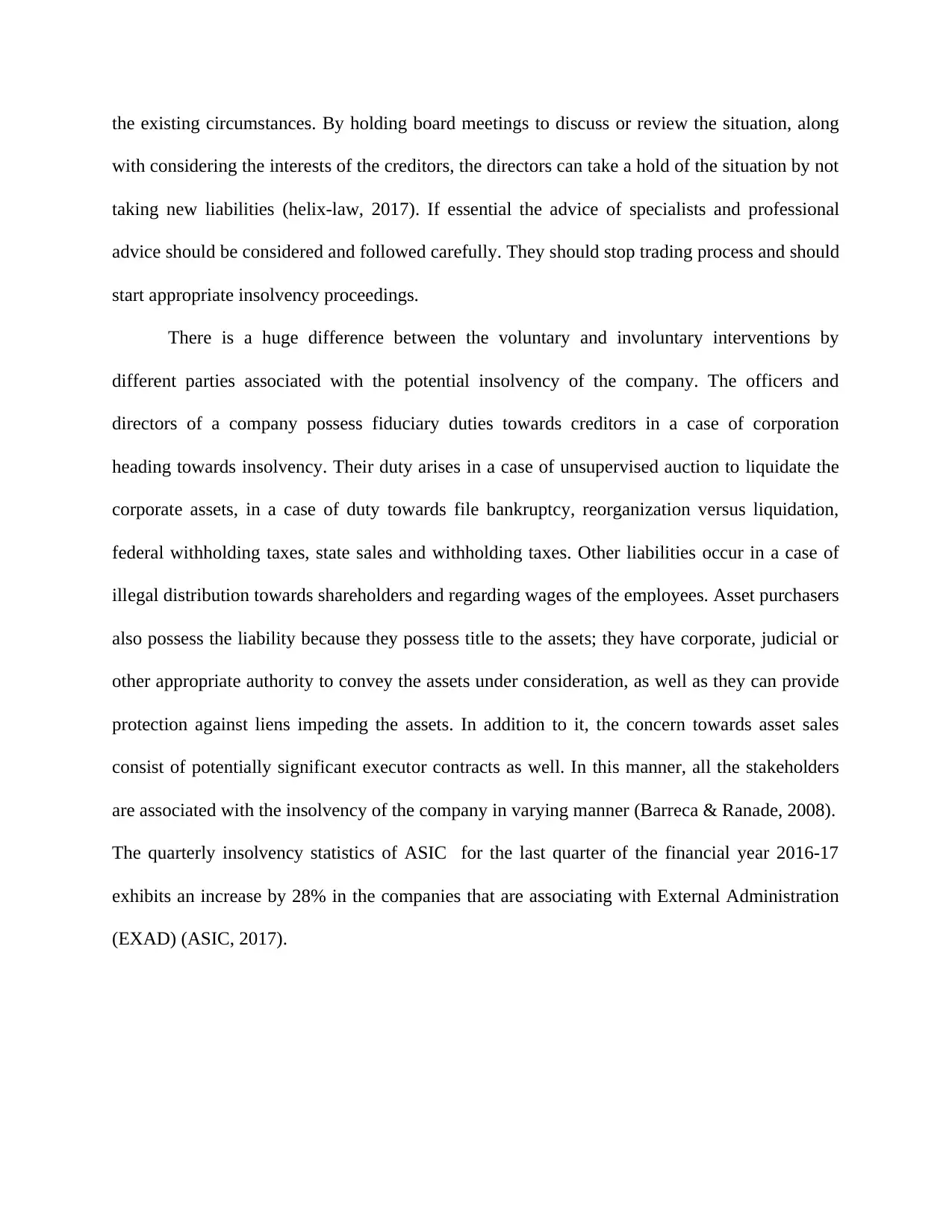
the existing circumstances. By holding board meetings to discuss or review the situation, along
with considering the interests of the creditors, the directors can take a hold of the situation by not
taking new liabilities (helix-law, 2017). If essential the advice of specialists and professional
advice should be considered and followed carefully. They should stop trading process and should
start appropriate insolvency proceedings.
There is a huge difference between the voluntary and involuntary interventions by
different parties associated with the potential insolvency of the company. The officers and
directors of a company possess fiduciary duties towards creditors in a case of corporation
heading towards insolvency. Their duty arises in a case of unsupervised auction to liquidate the
corporate assets, in a case of duty towards file bankruptcy, reorganization versus liquidation,
federal withholding taxes, state sales and withholding taxes. Other liabilities occur in a case of
illegal distribution towards shareholders and regarding wages of the employees. Asset purchasers
also possess the liability because they possess title to the assets; they have corporate, judicial or
other appropriate authority to convey the assets under consideration, as well as they can provide
protection against liens impeding the assets. In addition to it, the concern towards asset sales
consist of potentially significant executor contracts as well. In this manner, all the stakeholders
are associated with the insolvency of the company in varying manner (Barreca & Ranade, 2008).
The quarterly insolvency statistics of ASIC for the last quarter of the financial year 2016-17
exhibits an increase by 28% in the companies that are associating with External Administration
(EXAD) (ASIC, 2017).
with considering the interests of the creditors, the directors can take a hold of the situation by not
taking new liabilities (helix-law, 2017). If essential the advice of specialists and professional
advice should be considered and followed carefully. They should stop trading process and should
start appropriate insolvency proceedings.
There is a huge difference between the voluntary and involuntary interventions by
different parties associated with the potential insolvency of the company. The officers and
directors of a company possess fiduciary duties towards creditors in a case of corporation
heading towards insolvency. Their duty arises in a case of unsupervised auction to liquidate the
corporate assets, in a case of duty towards file bankruptcy, reorganization versus liquidation,
federal withholding taxes, state sales and withholding taxes. Other liabilities occur in a case of
illegal distribution towards shareholders and regarding wages of the employees. Asset purchasers
also possess the liability because they possess title to the assets; they have corporate, judicial or
other appropriate authority to convey the assets under consideration, as well as they can provide
protection against liens impeding the assets. In addition to it, the concern towards asset sales
consist of potentially significant executor contracts as well. In this manner, all the stakeholders
are associated with the insolvency of the company in varying manner (Barreca & Ranade, 2008).
The quarterly insolvency statistics of ASIC for the last quarter of the financial year 2016-17
exhibits an increase by 28% in the companies that are associating with External Administration
(EXAD) (ASIC, 2017).
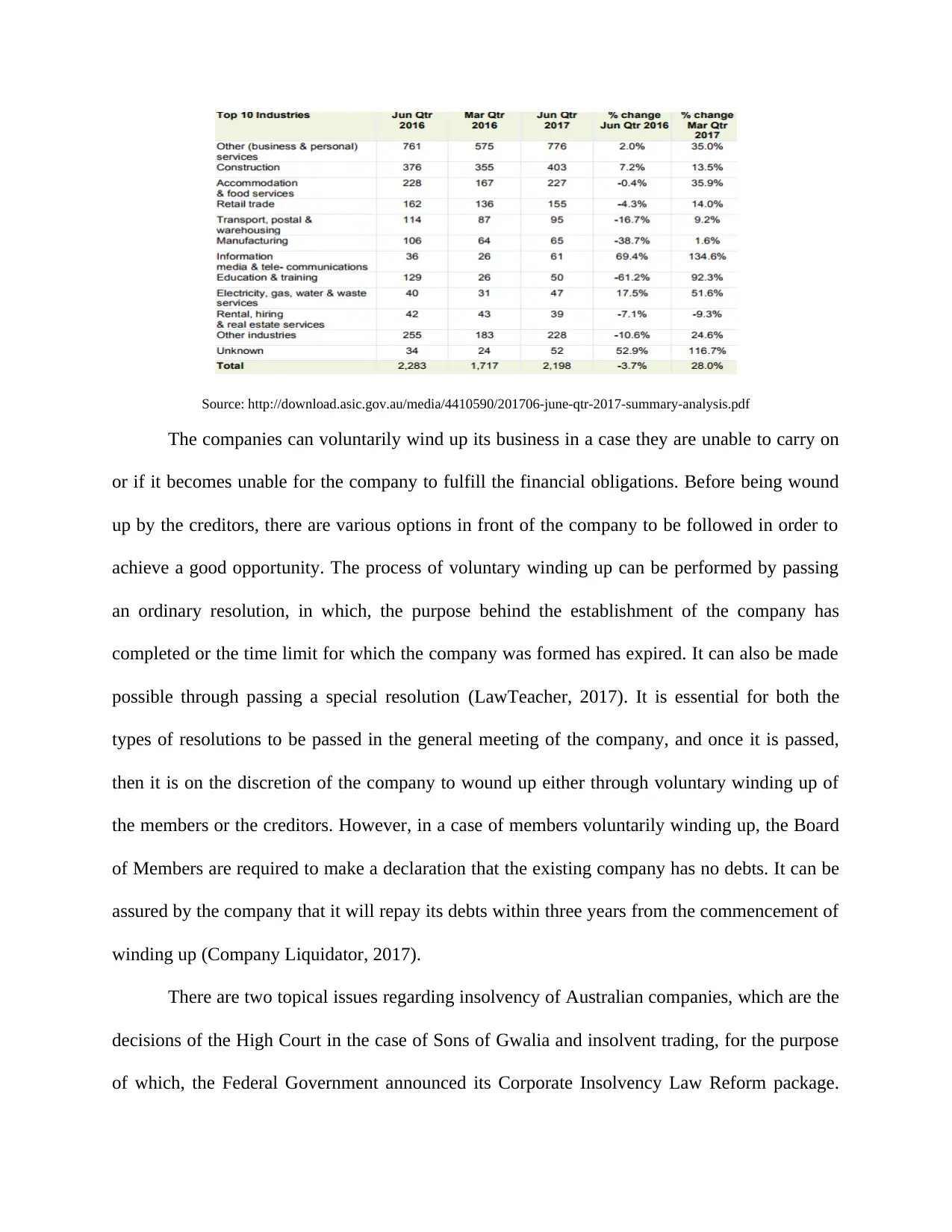
Source: http://download.asic.gov.au/media/4410590/201706-june-qtr-2017-summary-analysis.pdf
The companies can voluntarily wind up its business in a case they are unable to carry on
or if it becomes unable for the company to fulfill the financial obligations. Before being wound
up by the creditors, there are various options in front of the company to be followed in order to
achieve a good opportunity. The process of voluntary winding up can be performed by passing
an ordinary resolution, in which, the purpose behind the establishment of the company has
completed or the time limit for which the company was formed has expired. It can also be made
possible through passing a special resolution (LawTeacher, 2017). It is essential for both the
types of resolutions to be passed in the general meeting of the company, and once it is passed,
then it is on the discretion of the company to wound up either through voluntary winding up of
the members or the creditors. However, in a case of members voluntarily winding up, the Board
of Members are required to make a declaration that the existing company has no debts. It can be
assured by the company that it will repay its debts within three years from the commencement of
winding up (Company Liquidator, 2017).
There are two topical issues regarding insolvency of Australian companies, which are the
decisions of the High Court in the case of Sons of Gwalia and insolvent trading, for the purpose
of which, the Federal Government announced its Corporate Insolvency Law Reform package.
The companies can voluntarily wind up its business in a case they are unable to carry on
or if it becomes unable for the company to fulfill the financial obligations. Before being wound
up by the creditors, there are various options in front of the company to be followed in order to
achieve a good opportunity. The process of voluntary winding up can be performed by passing
an ordinary resolution, in which, the purpose behind the establishment of the company has
completed or the time limit for which the company was formed has expired. It can also be made
possible through passing a special resolution (LawTeacher, 2017). It is essential for both the
types of resolutions to be passed in the general meeting of the company, and once it is passed,
then it is on the discretion of the company to wound up either through voluntary winding up of
the members or the creditors. However, in a case of members voluntarily winding up, the Board
of Members are required to make a declaration that the existing company has no debts. It can be
assured by the company that it will repay its debts within three years from the commencement of
winding up (Company Liquidator, 2017).
There are two topical issues regarding insolvency of Australian companies, which are the
decisions of the High Court in the case of Sons of Gwalia and insolvent trading, for the purpose
of which, the Federal Government announced its Corporate Insolvency Law Reform package.
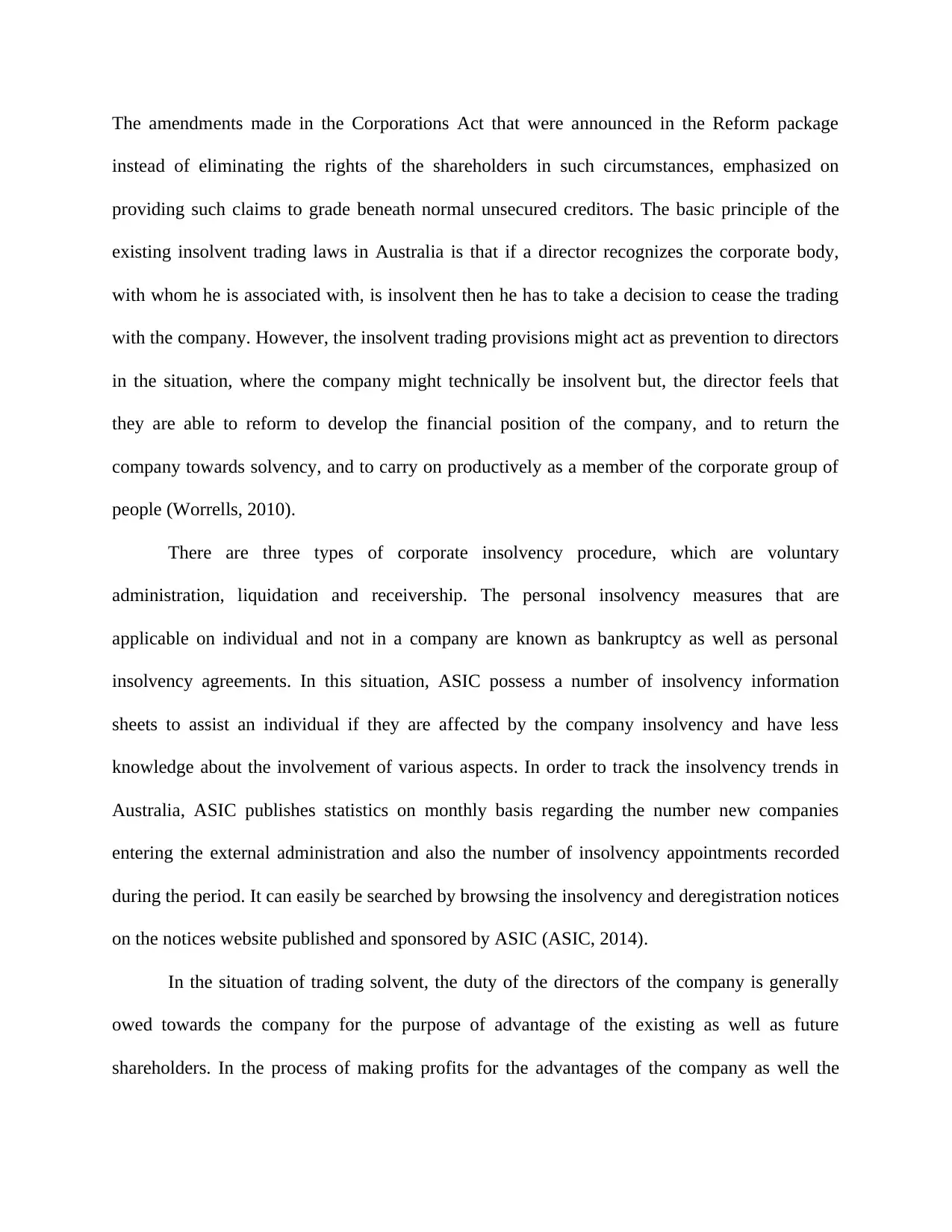
The amendments made in the Corporations Act that were announced in the Reform package
instead of eliminating the rights of the shareholders in such circumstances, emphasized on
providing such claims to grade beneath normal unsecured creditors. The basic principle of the
existing insolvent trading laws in Australia is that if a director recognizes the corporate body,
with whom he is associated with, is insolvent then he has to take a decision to cease the trading
with the company. However, the insolvent trading provisions might act as prevention to directors
in the situation, where the company might technically be insolvent but, the director feels that
they are able to reform to develop the financial position of the company, and to return the
company towards solvency, and to carry on productively as a member of the corporate group of
people (Worrells, 2010).
There are three types of corporate insolvency procedure, which are voluntary
administration, liquidation and receivership. The personal insolvency measures that are
applicable on individual and not in a company are known as bankruptcy as well as personal
insolvency agreements. In this situation, ASIC possess a number of insolvency information
sheets to assist an individual if they are affected by the company insolvency and have less
knowledge about the involvement of various aspects. In order to track the insolvency trends in
Australia, ASIC publishes statistics on monthly basis regarding the number new companies
entering the external administration and also the number of insolvency appointments recorded
during the period. It can easily be searched by browsing the insolvency and deregistration notices
on the notices website published and sponsored by ASIC (ASIC, 2014).
In the situation of trading solvent, the duty of the directors of the company is generally
owed towards the company for the purpose of advantage of the existing as well as future
shareholders. In the process of making profits for the advantages of the company as well the
instead of eliminating the rights of the shareholders in such circumstances, emphasized on
providing such claims to grade beneath normal unsecured creditors. The basic principle of the
existing insolvent trading laws in Australia is that if a director recognizes the corporate body,
with whom he is associated with, is insolvent then he has to take a decision to cease the trading
with the company. However, the insolvent trading provisions might act as prevention to directors
in the situation, where the company might technically be insolvent but, the director feels that
they are able to reform to develop the financial position of the company, and to return the
company towards solvency, and to carry on productively as a member of the corporate group of
people (Worrells, 2010).
There are three types of corporate insolvency procedure, which are voluntary
administration, liquidation and receivership. The personal insolvency measures that are
applicable on individual and not in a company are known as bankruptcy as well as personal
insolvency agreements. In this situation, ASIC possess a number of insolvency information
sheets to assist an individual if they are affected by the company insolvency and have less
knowledge about the involvement of various aspects. In order to track the insolvency trends in
Australia, ASIC publishes statistics on monthly basis regarding the number new companies
entering the external administration and also the number of insolvency appointments recorded
during the period. It can easily be searched by browsing the insolvency and deregistration notices
on the notices website published and sponsored by ASIC (ASIC, 2014).
In the situation of trading solvent, the duty of the directors of the company is generally
owed towards the company for the purpose of advantage of the existing as well as future
shareholders. In the process of making profits for the advantages of the company as well the
Paraphrase This Document
Need a fresh take? Get an instant paraphrase of this document with our AI Paraphraser
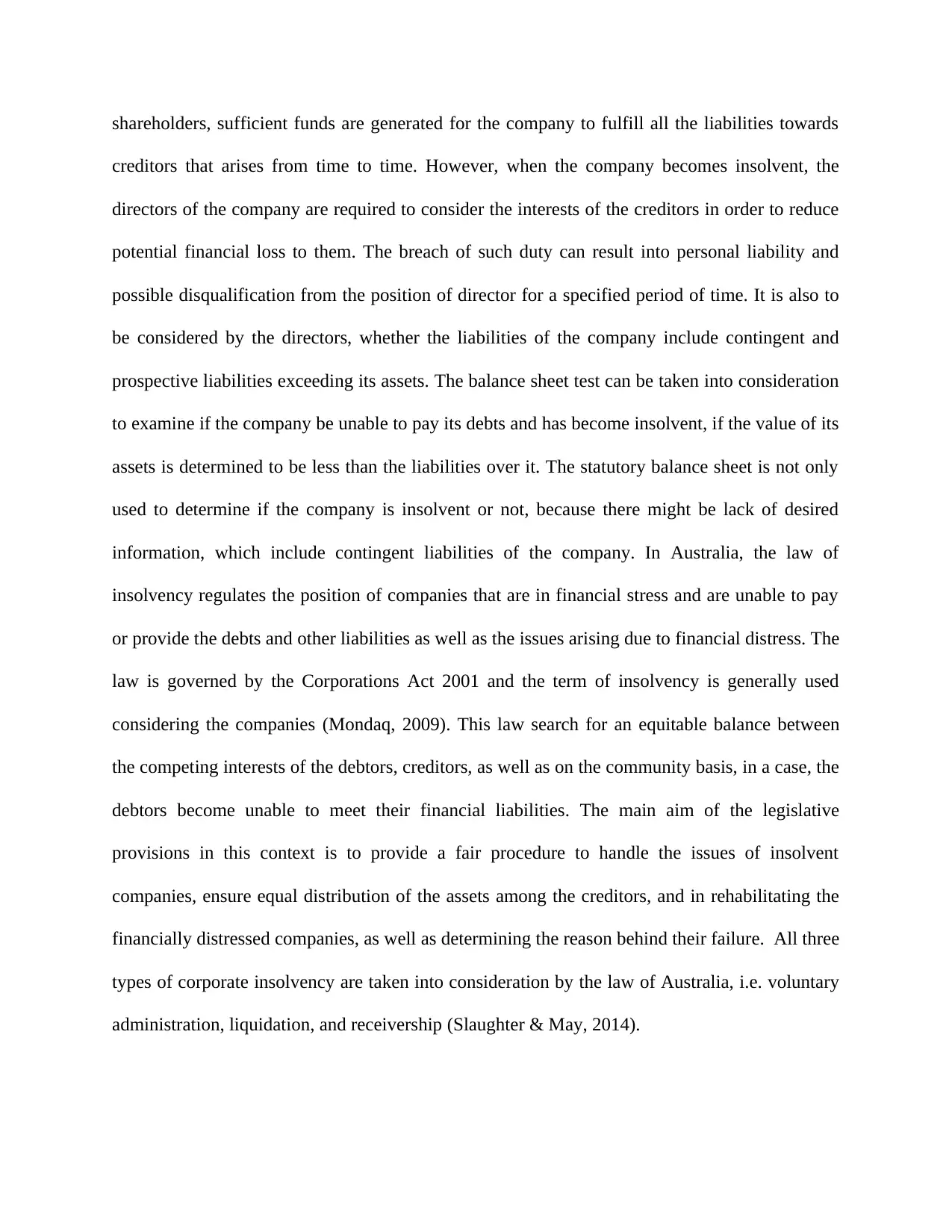
shareholders, sufficient funds are generated for the company to fulfill all the liabilities towards
creditors that arises from time to time. However, when the company becomes insolvent, the
directors of the company are required to consider the interests of the creditors in order to reduce
potential financial loss to them. The breach of such duty can result into personal liability and
possible disqualification from the position of director for a specified period of time. It is also to
be considered by the directors, whether the liabilities of the company include contingent and
prospective liabilities exceeding its assets. The balance sheet test can be taken into consideration
to examine if the company be unable to pay its debts and has become insolvent, if the value of its
assets is determined to be less than the liabilities over it. The statutory balance sheet is not only
used to determine if the company is insolvent or not, because there might be lack of desired
information, which include contingent liabilities of the company. In Australia, the law of
insolvency regulates the position of companies that are in financial stress and are unable to pay
or provide the debts and other liabilities as well as the issues arising due to financial distress. The
law is governed by the Corporations Act 2001 and the term of insolvency is generally used
considering the companies (Mondaq, 2009). This law search for an equitable balance between
the competing interests of the debtors, creditors, as well as on the community basis, in a case, the
debtors become unable to meet their financial liabilities. The main aim of the legislative
provisions in this context is to provide a fair procedure to handle the issues of insolvent
companies, ensure equal distribution of the assets among the creditors, and in rehabilitating the
financially distressed companies, as well as determining the reason behind their failure. All three
types of corporate insolvency are taken into consideration by the law of Australia, i.e. voluntary
administration, liquidation, and receivership (Slaughter & May, 2014).
creditors that arises from time to time. However, when the company becomes insolvent, the
directors of the company are required to consider the interests of the creditors in order to reduce
potential financial loss to them. The breach of such duty can result into personal liability and
possible disqualification from the position of director for a specified period of time. It is also to
be considered by the directors, whether the liabilities of the company include contingent and
prospective liabilities exceeding its assets. The balance sheet test can be taken into consideration
to examine if the company be unable to pay its debts and has become insolvent, if the value of its
assets is determined to be less than the liabilities over it. The statutory balance sheet is not only
used to determine if the company is insolvent or not, because there might be lack of desired
information, which include contingent liabilities of the company. In Australia, the law of
insolvency regulates the position of companies that are in financial stress and are unable to pay
or provide the debts and other liabilities as well as the issues arising due to financial distress. The
law is governed by the Corporations Act 2001 and the term of insolvency is generally used
considering the companies (Mondaq, 2009). This law search for an equitable balance between
the competing interests of the debtors, creditors, as well as on the community basis, in a case, the
debtors become unable to meet their financial liabilities. The main aim of the legislative
provisions in this context is to provide a fair procedure to handle the issues of insolvent
companies, ensure equal distribution of the assets among the creditors, and in rehabilitating the
financially distressed companies, as well as determining the reason behind their failure. All three
types of corporate insolvency are taken into consideration by the law of Australia, i.e. voluntary
administration, liquidation, and receivership (Slaughter & May, 2014).
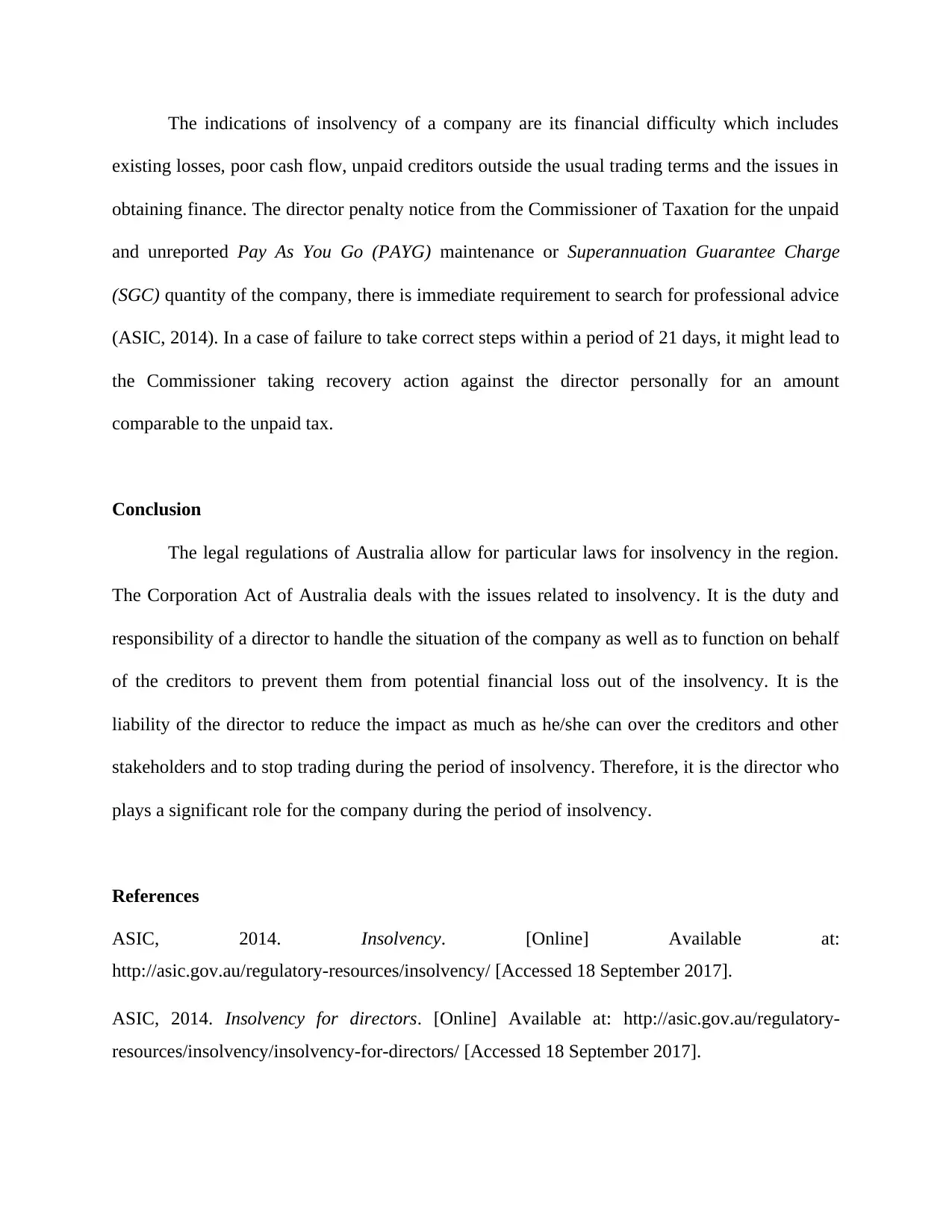
The indications of insolvency of a company are its financial difficulty which includes
existing losses, poor cash flow, unpaid creditors outside the usual trading terms and the issues in
obtaining finance. The director penalty notice from the Commissioner of Taxation for the unpaid
and unreported Pay As You Go (PAYG) maintenance or Superannuation Guarantee Charge
(SGC) quantity of the company, there is immediate requirement to search for professional advice
(ASIC, 2014). In a case of failure to take correct steps within a period of 21 days, it might lead to
the Commissioner taking recovery action against the director personally for an amount
comparable to the unpaid tax.
Conclusion
The legal regulations of Australia allow for particular laws for insolvency in the region.
The Corporation Act of Australia deals with the issues related to insolvency. It is the duty and
responsibility of a director to handle the situation of the company as well as to function on behalf
of the creditors to prevent them from potential financial loss out of the insolvency. It is the
liability of the director to reduce the impact as much as he/she can over the creditors and other
stakeholders and to stop trading during the period of insolvency. Therefore, it is the director who
plays a significant role for the company during the period of insolvency.
References
ASIC, 2014. Insolvency. [Online] Available at:
http://asic.gov.au/regulatory-resources/insolvency/ [Accessed 18 September 2017].
ASIC, 2014. Insolvency for directors. [Online] Available at: http://asic.gov.au/regulatory-
resources/insolvency/insolvency-for-directors/ [Accessed 18 September 2017].
existing losses, poor cash flow, unpaid creditors outside the usual trading terms and the issues in
obtaining finance. The director penalty notice from the Commissioner of Taxation for the unpaid
and unreported Pay As You Go (PAYG) maintenance or Superannuation Guarantee Charge
(SGC) quantity of the company, there is immediate requirement to search for professional advice
(ASIC, 2014). In a case of failure to take correct steps within a period of 21 days, it might lead to
the Commissioner taking recovery action against the director personally for an amount
comparable to the unpaid tax.
Conclusion
The legal regulations of Australia allow for particular laws for insolvency in the region.
The Corporation Act of Australia deals with the issues related to insolvency. It is the duty and
responsibility of a director to handle the situation of the company as well as to function on behalf
of the creditors to prevent them from potential financial loss out of the insolvency. It is the
liability of the director to reduce the impact as much as he/she can over the creditors and other
stakeholders and to stop trading during the period of insolvency. Therefore, it is the director who
plays a significant role for the company during the period of insolvency.
References
ASIC, 2014. Insolvency. [Online] Available at:
http://asic.gov.au/regulatory-resources/insolvency/ [Accessed 18 September 2017].
ASIC, 2014. Insolvency for directors. [Online] Available at: http://asic.gov.au/regulatory-
resources/insolvency/insolvency-for-directors/ [Accessed 18 September 2017].
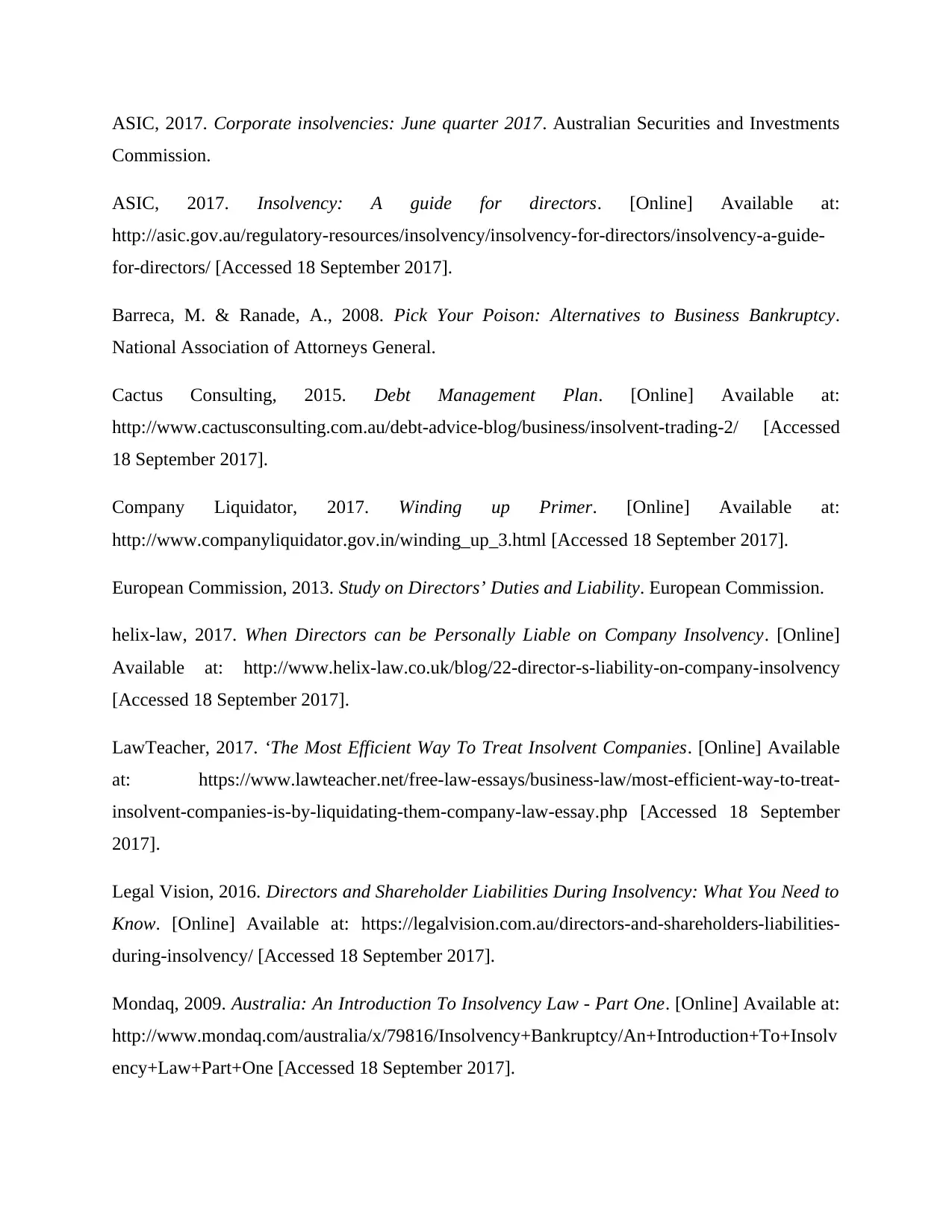
ASIC, 2017. Corporate insolvencies: June quarter 2017. Australian Securities and Investments
Commission.
ASIC, 2017. Insolvency: A guide for directors. [Online] Available at:
http://asic.gov.au/regulatory-resources/insolvency/insolvency-for-directors/insolvency-a-guide-
for-directors/ [Accessed 18 September 2017].
Barreca, M. & Ranade, A., 2008. Pick Your Poison: Alternatives to Business Bankruptcy.
National Association of Attorneys General.
Cactus Consulting, 2015. Debt Management Plan. [Online] Available at:
http://www.cactusconsulting.com.au/debt-advice-blog/business/insolvent-trading-2/ [Accessed
18 September 2017].
Company Liquidator, 2017. Winding up Primer. [Online] Available at:
http://www.companyliquidator.gov.in/winding_up_3.html [Accessed 18 September 2017].
European Commission, 2013. Study on Directors’ Duties and Liability. European Commission.
helix-law, 2017. When Directors can be Personally Liable on Company Insolvency. [Online]
Available at: http://www.helix-law.co.uk/blog/22-director-s-liability-on-company-insolvency
[Accessed 18 September 2017].
LawTeacher, 2017. ‘The Most Efficient Way To Treat Insolvent Companies. [Online] Available
at: https://www.lawteacher.net/free-law-essays/business-law/most-efficient-way-to-treat-
insolvent-companies-is-by-liquidating-them-company-law-essay.php [Accessed 18 September
2017].
Legal Vision, 2016. Directors and Shareholder Liabilities During Insolvency: What You Need to
Know. [Online] Available at: https://legalvision.com.au/directors-and-shareholders-liabilities-
during-insolvency/ [Accessed 18 September 2017].
Mondaq, 2009. Australia: An Introduction To Insolvency Law - Part One. [Online] Available at:
http://www.mondaq.com/australia/x/79816/Insolvency+Bankruptcy/An+Introduction+To+Insolv
ency+Law+Part+One [Accessed 18 September 2017].
Commission.
ASIC, 2017. Insolvency: A guide for directors. [Online] Available at:
http://asic.gov.au/regulatory-resources/insolvency/insolvency-for-directors/insolvency-a-guide-
for-directors/ [Accessed 18 September 2017].
Barreca, M. & Ranade, A., 2008. Pick Your Poison: Alternatives to Business Bankruptcy.
National Association of Attorneys General.
Cactus Consulting, 2015. Debt Management Plan. [Online] Available at:
http://www.cactusconsulting.com.au/debt-advice-blog/business/insolvent-trading-2/ [Accessed
18 September 2017].
Company Liquidator, 2017. Winding up Primer. [Online] Available at:
http://www.companyliquidator.gov.in/winding_up_3.html [Accessed 18 September 2017].
European Commission, 2013. Study on Directors’ Duties and Liability. European Commission.
helix-law, 2017. When Directors can be Personally Liable on Company Insolvency. [Online]
Available at: http://www.helix-law.co.uk/blog/22-director-s-liability-on-company-insolvency
[Accessed 18 September 2017].
LawTeacher, 2017. ‘The Most Efficient Way To Treat Insolvent Companies. [Online] Available
at: https://www.lawteacher.net/free-law-essays/business-law/most-efficient-way-to-treat-
insolvent-companies-is-by-liquidating-them-company-law-essay.php [Accessed 18 September
2017].
Legal Vision, 2016. Directors and Shareholder Liabilities During Insolvency: What You Need to
Know. [Online] Available at: https://legalvision.com.au/directors-and-shareholders-liabilities-
during-insolvency/ [Accessed 18 September 2017].
Mondaq, 2009. Australia: An Introduction To Insolvency Law - Part One. [Online] Available at:
http://www.mondaq.com/australia/x/79816/Insolvency+Bankruptcy/An+Introduction+To+Insolv
ency+Law+Part+One [Accessed 18 September 2017].
Secure Best Marks with AI Grader
Need help grading? Try our AI Grader for instant feedback on your assignments.
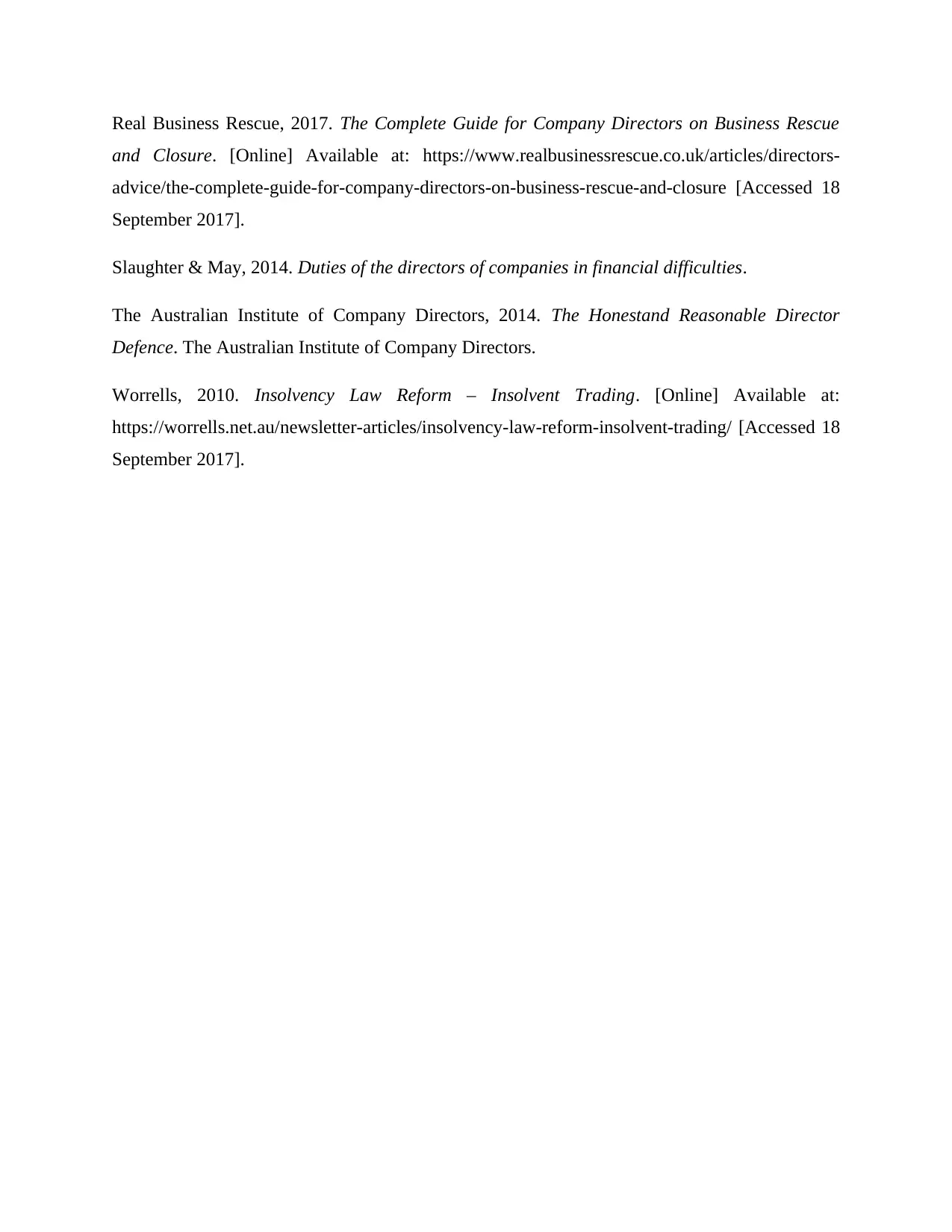
Real Business Rescue, 2017. The Complete Guide for Company Directors on Business Rescue
and Closure. [Online] Available at: https://www.realbusinessrescue.co.uk/articles/directors-
advice/the-complete-guide-for-company-directors-on-business-rescue-and-closure [Accessed 18
September 2017].
Slaughter & May, 2014. Duties of the directors of companies in financial difficulties.
The Australian Institute of Company Directors, 2014. The Honestand Reasonable Director
Defence. The Australian Institute of Company Directors.
Worrells, 2010. Insolvency Law Reform – Insolvent Trading. [Online] Available at:
https://worrells.net.au/newsletter-articles/insolvency-law-reform-insolvent-trading/ [Accessed 18
September 2017].
and Closure. [Online] Available at: https://www.realbusinessrescue.co.uk/articles/directors-
advice/the-complete-guide-for-company-directors-on-business-rescue-and-closure [Accessed 18
September 2017].
Slaughter & May, 2014. Duties of the directors of companies in financial difficulties.
The Australian Institute of Company Directors, 2014. The Honestand Reasonable Director
Defence. The Australian Institute of Company Directors.
Worrells, 2010. Insolvency Law Reform – Insolvent Trading. [Online] Available at:
https://worrells.net.au/newsletter-articles/insolvency-law-reform-insolvent-trading/ [Accessed 18
September 2017].
1 out of 11
Related Documents
Your All-in-One AI-Powered Toolkit for Academic Success.
+13062052269
info@desklib.com
Available 24*7 on WhatsApp / Email
![[object Object]](/_next/static/media/star-bottom.7253800d.svg)
Unlock your academic potential
© 2024 | Zucol Services PVT LTD | All rights reserved.





